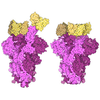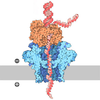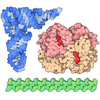[English] 日本語
 Yorodumi
Yorodumi- PDB-9ccu: CryoEM Structure of Escherichia coli FimCH in complex with F7 Fab -
+ Open data
Open data
- Basic information
Basic information
| Entry | Database: PDB / ID: 9ccu | |||||||||||||||
|---|---|---|---|---|---|---|---|---|---|---|---|---|---|---|---|---|
| Title | CryoEM Structure of Escherichia coli FimCH in complex with F7 Fab | |||||||||||||||
 Components Components |
| |||||||||||||||
 Keywords Keywords | CELL ADHESION / Adhesin / Inhibitor / complex / Fab / Chaperone / Usher / Pili | |||||||||||||||
| Function / homology |  Function and homology information Function and homology information | |||||||||||||||
| Biological species |   | |||||||||||||||
| Method | ELECTRON MICROSCOPY / single particle reconstruction / cryo EM / Resolution: 3.8 Å | |||||||||||||||
 Authors Authors | Lopatto, E.D.B. / Hultgren, S.J. | |||||||||||||||
| Funding support |  United States, 4items United States, 4items
| |||||||||||||||
 Citation Citation |  Journal: Sci Adv / Year: 2025 Journal: Sci Adv / Year: 2025Title: Monoclonal antibodies targeting the FimH adhesin protect against uropathogenic UTI. Authors: Edward D B Lopatto / Jesús M Santiago-Borges / Denise A Sanick / Sameer Kumar Malladi / Philippe N Azimzadeh / Morgan W Timm / Isabella F Fox / Aaron J Schmitz / Jackson S Turner / Shaza M ...Authors: Edward D B Lopatto / Jesús M Santiago-Borges / Denise A Sanick / Sameer Kumar Malladi / Philippe N Azimzadeh / Morgan W Timm / Isabella F Fox / Aaron J Schmitz / Jackson S Turner / Shaza M Sayed Ahmed / Lillian Ortinau / Nathaniel C Gualberto / Jerome S Pinkner / Karen W Dodson / Ali H Ellebedy / Andrew L Kau / Scott J Hultgren /  Abstract: As antimicrobial resistance increases, urinary tract infections (UTIs) are expected to pose an increased burden in morbidity and expense on the health care system, increasing the need for alternative ...As antimicrobial resistance increases, urinary tract infections (UTIs) are expected to pose an increased burden in morbidity and expense on the health care system, increasing the need for alternative antibiotic-sparing treatments. Most UTIs are caused by uropathogenic (UPEC), whereas causes a large portion of non-UPEC UTIs. Both bacteria express type 1 pili tipped with the mannose-binding FimH adhesin critical for UTI pathogenesis. We generated and biochemically characterized 33 murine monoclonal antibodies (mAbs) to FimH. Three mAbs protected mice from UTI. Mechanistically, we show that this protection is Fc independent and mediated by the ability of these mAbs to sterically block FimH function by recognizing a high-affinity FimH conformation. Our data reveal that FimH mAbs hold promise as an antibiotic-sparing treatment strategy. | |||||||||||||||
| History |
|
- Structure visualization
Structure visualization
| Structure viewer | Molecule:  Molmil Molmil Jmol/JSmol Jmol/JSmol |
|---|
- Downloads & links
Downloads & links
- Download
Download
| PDBx/mmCIF format |  9ccu.cif.gz 9ccu.cif.gz | 113.9 KB | Display |  PDBx/mmCIF format PDBx/mmCIF format |
|---|---|---|---|---|
| PDB format |  pdb9ccu.ent.gz pdb9ccu.ent.gz | 85.6 KB | Display |  PDB format PDB format |
| PDBx/mmJSON format |  9ccu.json.gz 9ccu.json.gz | Tree view |  PDBx/mmJSON format PDBx/mmJSON format | |
| Others |  Other downloads Other downloads |
-Validation report
| Arichive directory |  https://data.pdbj.org/pub/pdb/validation_reports/cc/9ccu https://data.pdbj.org/pub/pdb/validation_reports/cc/9ccu ftp://data.pdbj.org/pub/pdb/validation_reports/cc/9ccu ftp://data.pdbj.org/pub/pdb/validation_reports/cc/9ccu | HTTPS FTP |
|---|
-Related structure data
| Related structure data |  45458MC  9ccsC  9cctC  9ccwC M: map data used to model this data C: citing same article ( |
|---|---|
| Similar structure data | Similarity search - Function & homology  F&H Search F&H Search |
- Links
Links
- Assembly
Assembly
| Deposited unit | 
|
|---|---|
| 1 |
|
- Components
Components
| #1: Protein | Mass: 29037.260 Da / Num. of mol.: 1 Source method: isolated from a genetically manipulated source Source: (gene. exp.)   |
|---|---|
| #2: Antibody | Mass: 23781.291 Da / Num. of mol.: 1 Source method: isolated from a genetically manipulated source Source: (gene. exp.)   Homo sapiens (human) Homo sapiens (human) |
| #3: Antibody | Mass: 26131.266 Da / Num. of mol.: 1 Source method: isolated from a genetically manipulated source Source: (gene. exp.)   Homo sapiens (human) Homo sapiens (human) |
| Has protein modification | Y |
-Experimental details
-Experiment
| Experiment | Method: ELECTRON MICROSCOPY |
|---|---|
| EM experiment | Aggregation state: PARTICLE / 3D reconstruction method: single particle reconstruction |
- Sample preparation
Sample preparation
| Component |
| ||||||||||||||||||||||||||||
|---|---|---|---|---|---|---|---|---|---|---|---|---|---|---|---|---|---|---|---|---|---|---|---|---|---|---|---|---|---|
| Molecular weight |
| ||||||||||||||||||||||||||||
| Source (natural) |
| ||||||||||||||||||||||||||||
| Source (recombinant) |
| ||||||||||||||||||||||||||||
| Buffer solution | pH: 7.5 | ||||||||||||||||||||||||||||
| Buffer component |
| ||||||||||||||||||||||||||||
| Specimen | Conc.: 0.15 mg/ml / Embedding applied: NO / Shadowing applied: NO / Staining applied: NO / Vitrification applied: YES | ||||||||||||||||||||||||||||
| Vitrification | Cryogen name: ETHANE |
- Electron microscopy imaging
Electron microscopy imaging
| Microscopy | Model: TFS GLACIOS |
|---|---|
| Electron gun | Electron source:  FIELD EMISSION GUN / Accelerating voltage: 200 kV / Illumination mode: SPOT SCAN FIELD EMISSION GUN / Accelerating voltage: 200 kV / Illumination mode: SPOT SCAN |
| Electron lens | Mode: BRIGHT FIELD / Nominal defocus max: 2400 nm / Nominal defocus min: 1000 nm |
| Image recording | Electron dose: 43 e/Å2 / Film or detector model: TFS FALCON 4i (4k x 4k) |
- Processing
Processing
| EM software | Name: PHENIX / Category: model refinement | ||||||||||||||||||||||||
|---|---|---|---|---|---|---|---|---|---|---|---|---|---|---|---|---|---|---|---|---|---|---|---|---|---|
| CTF correction | Type: PHASE FLIPPING AND AMPLITUDE CORRECTION | ||||||||||||||||||||||||
| 3D reconstruction | Resolution: 3.8 Å / Resolution method: FSC 0.143 CUT-OFF / Num. of particles: 129896 / Symmetry type: POINT | ||||||||||||||||||||||||
| Refine LS restraints |
|
 Movie
Movie Controller
Controller





 PDBj
PDBj







